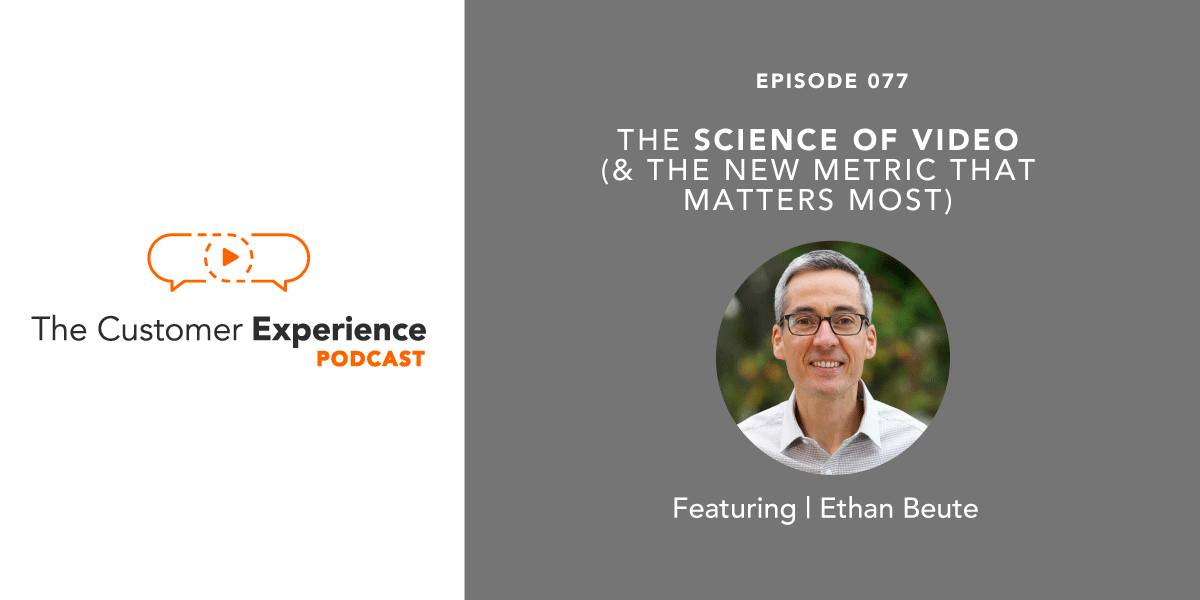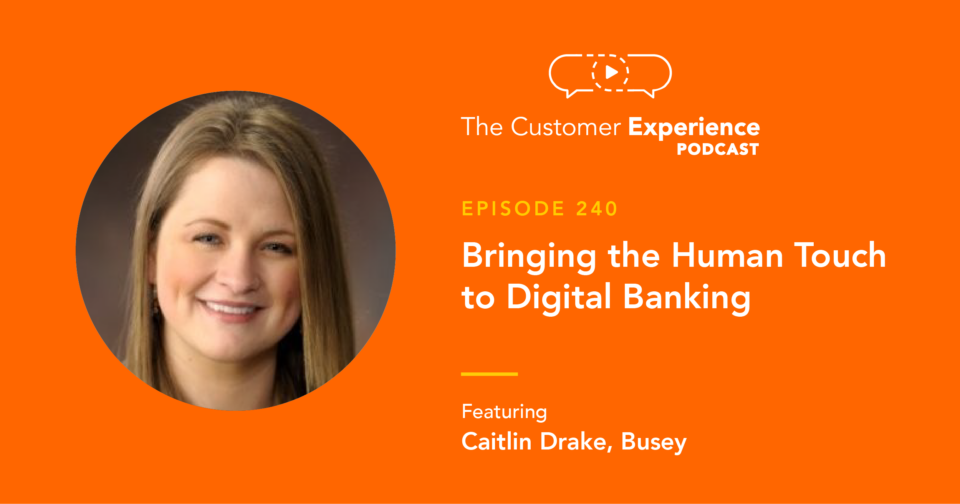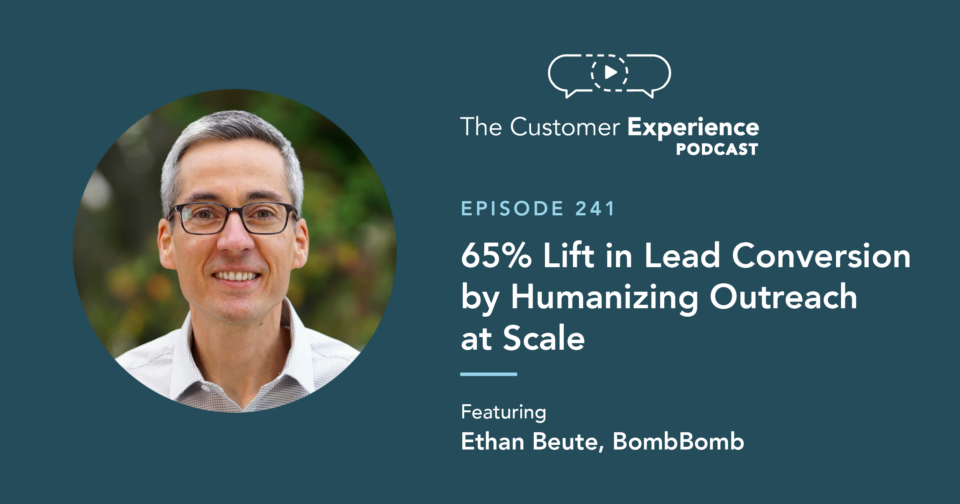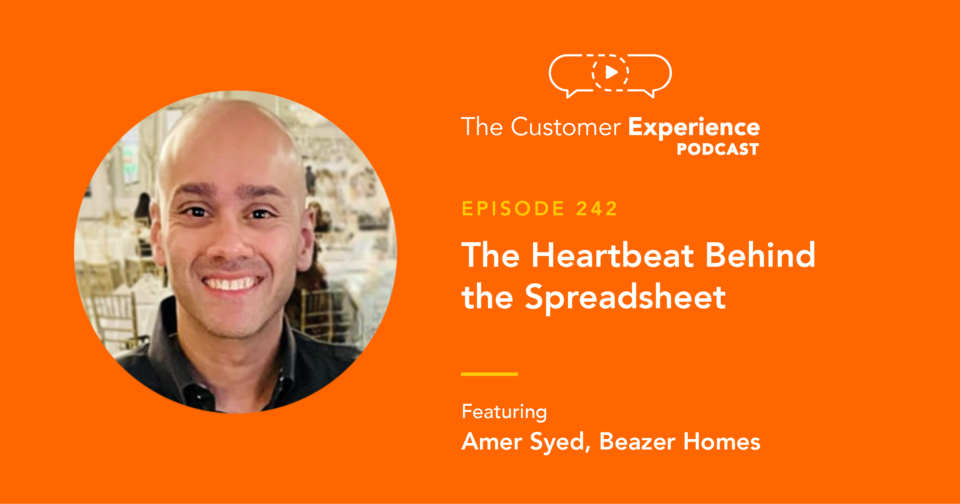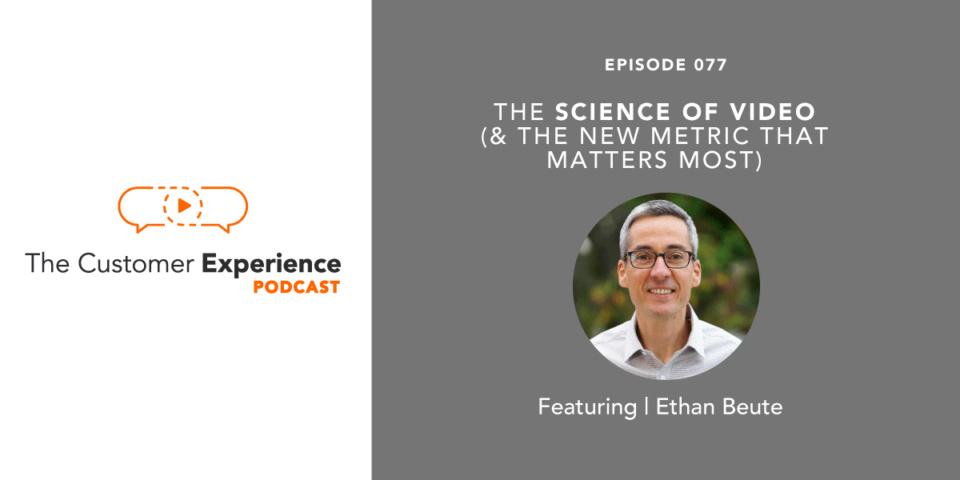
Apple Podcasts | Google Podcasts | Stitcher | Spotify
As fellow humans, we all communicate more effectively in person. Yet, we still rely on faceless, typed-out text to get important messages across that our businesses depend on. Every time we do that, we risk compromising the integrity and efficacy of our messages in the process. And … it’s dehumanizing.
With important outcomes and results on the line, this shouldn’t be a risk we’re so willing to take – especially when there’s a better option: video messages.
Video brings you face to face with more people in less time. The tone and intent of your message doesn’t get lost in translation – and you’re able to include eye contact, facial expressions, and other nonverbal cues for added clarity and connection.
Ultimately, face-to-face interactions draw people to you. So much so, that face-to-face communication should be a new metric to keep a close eye on.
There is plenty of science that backs video as a more effective communication medium than our typed-out emails, text messages, and social messages. And we share some of that science in this episode of The Customer Experience Podcast.
This short episode is based on a presentation I recently created and delivered for the Narrative Science Data Storytelling Virtual Summit. Thanks again to the team at Narrative Science for the opportunity!
It’s not just audio stripped from the presentation recording; I’ve adapted it specifically for the podcast format. The video recording, however, is embedded below if you’d like to see it with slides and with a little box with my face.
I’m Ethan Beute, Chief Evangelist at BombBomb, host of The Customer Experience Podcast, and co-host of the CX Series on the B2B Growth.
By giving this one a listen, you’ll learn about the science of video from three of our outstanding podcast guests, expected results from video messaging, key metrics to pay attention to, and a new metric that I’ll argue matters most for its transcendent qualities. Among the topics …
• What video accomplishes that plain text can’t replicate
• Why there’s an innate human interest in faces (and how our attention wanes when we see a profile instead)
• How video makes us feel like we’re in close proximity emotionally
• How video jumpstarts social bonding
• Why face-to-face time is the metric that matters most in video messaging
The Science of Video (and the New Metric That Matters Most)
Please give this one a listen and reach out with feedback.
Hear the entire episode right here:
Listen to “77. The Science of Video (& the New Metric That Matters Most) w/ Ethan Beute” on Spreaker.
Prefer to listen in a podcast player?
Subscribe, listen, rate, and review The Customer Experience Podcast here:

Full Transcript: The Science of Video (and the New Metric That Matters Most)
Ethan Beute:
Are you better in person? It’s a simple question, but it has profound impacts on your behavior every single day. Are you better in person? Are you more effective when you get face to face with people?
Ethan Beute:
And the answer to this question is very obviously yes if you are a human being. When you get face to face, you enjoy clearer communication because it’s infused with all that rich nonverbal communication, facial expression, tone, pace, all those other things that don’t come through when you rely, let’s say on a typed out email or a typed-out text message or a typed out LinkedIn message.
Ethan Beute:
We also enjoy human connection.
Ethan Beute:
We’re drawn together through eye contact. And as you’ll hear in this episode, we build psychological proximity, psychological nearness, real human connection, when we get face to face. And of course, we enjoy higher conversion, we’re more effective, we’re more persuasive.
Ethan Beute:
And when I say conversion, I don’t just mean sales and marketing conversions, and moving people through the funnel. I mean, all of the little micro yeses that we need every single day to be successful. This is yes, I’ll reply to your email. Yes, I’ll return your phone call. Yes, I’ll fill out that survey. Yes, I will take the time to meet with you. Yes, I will make that mutual introduction. Yes, I will give you some honest feedback. Yes, I’ll give you some advice based on my own experience, all of these micro yeses, and of course the macro yeses as well, like signed contracts and commitments.
Ethan Beute:
And so we are better in person, but when we think about all of the messages that we’re sending throughout the day, and all of the messages that are being sent on our behalf by systems that we have set up, automations and things, these are some of our most important and valuable messages and yet we’re entrusting them typically to a form of communication that doesn’t differentiate us, doesn’t build trust and rapport, and doesn’t communicate nearly as well as when we look people in the eye. This is faceless, digital communication, plain typed out text, the same black text on the same white screen.
Ethan Beute:
And these aren’t just our most important and valuable messages. They are also our most important and valuable relationships. It’s not about the message, it’s about who we’re connecting and communicating with. And so we need to be more effective, but before we get there, a fun fact. One of the reasons that we’re so effective as fellow human beings and social creatures, when we are in-person, when we are face-to-face is that we’ve been doing it for hundreds of thousands of years.
Ethan Beute:
I’ve seen lower estimates and I’ve seen higher estimates. But the number that I go with is 150,000 years, that humans have been looking one another in the eye and speaking to one another. How long have we been writing? Well, humans have been capturing phonetic sounds and writing them down in order to communicate with each other for about 5,000 years.
Ethan Beute:
But that number is off by a factor of 10 because even in the Western developed world, literacy only began to spread about 500 years ago. So we’ve been speaking to one another eye-to-eye, face to face and building evolutionary benefit in deep experience as a species doing this. For 300 times longer, or if you like percentages that’s a 29,900% lift in the amount of time that we’ve been communicating face-to-face rather than through typed out or written words.
Ethan Beute:
This is the science of video and the metrics that matter most. This is a presentation I put together for the Narrative Science Data Storytelling Summit. It was an absolute privilege to present there. I’m not giving you the audio from that presentation, although, if you visit bombbomb.com/podcast, you can watch the recording with audio and with slides.
Ethan Beute:
I’m going to give you an adapted version specific to the podcast format, so I’m not referring to things that you cannot see. Again, the science of video and the metrics that matter most.
Ethan Beute:
My name is Ethan Beute, I’m Chief Evangelist at BombBomb, obviously the host of The Customer Experience Podcast and cohost of the CX Series on the B2B Growth Show. And in addition, I’m the coauthor of a book called Rehumanize your Business: How Personal Videos Accelerate Sales and Improve the Customer Experience.
Ethan Beute:
And when I talk about video here in the science of video, I’m not so much talking about live synchronous video. Of course, we’re all doing Zoom calls as we’re forced out of the office and having to work remotely. We’re not so much talking about live synchronous video. That helps you overcome distance, any two people or any 200 people that are internet-connected anywhere in the world can get together to overcome distance, but you can’t overcome time. You still have to be there at 9:00 Pacific or was that 8:00 Pacific, noon Eastern, that kind of a thing.
Ethan Beute:
“Are you still good today at 4:00?” “No, it doesn’t work for me. How about tomorrow at 1:00?” Right. So we still need to be synchronous. We still need to be there at the same time. I’m also not talking about something that we generically, something that we, and I’m not talking about … something that we call marketing through video.
Ethan Beute:
This is video that requires lights, scripts, budgets, drones, green screens, specialized equipment, and all of these other things that prevent a lot of people from getting going with video. Or saying, “Oh, video is for them, video is for the marketing department or the production department.”
Ethan Beute:
Instead, what I’m talking about is what we call relationships through video, which is video for everyone. Simple recorded video messages from your webcam or your smartphone that overcome both time and distance. You record the messages when it’s convenient for you, you send it to one person or six people or 25 people or 2,500 people and each person opens it up and experiences you in person at their own convenience. So it overcomes time and distance, but still allows you all the benefits of face to face.
Ethan Beute:
And so what I’m going to share with you here are three experts, insights on the science of video. I’ll talk about some of the measurable outcomes that you can expect from video. Some of the common metrics people are looking at right now, and a new metric that I will argue transcends all the other ones that is probably, it is the metric that matters most.
Ethan Beute:
So our three experts are all guests on The Customer Experience Podcast. I’m going to play back for you some of their own words here on the show.
Ethan Beute:
And first up is Dan Hill, who is a facial coding expert and who does a lot of work in emotional intelligence, EQ. In fact, Dan is an expert in EQ or emotional intelligence, and he’s a facial coding expert. He holds seven US patents in the analysis of facial coding data. He’s also authored several books, including Emotionomics, which is his most successful business book and Famous Faces Decoded.
Ethan Beute:
In this clip Dan talks about why humans focus on each other’s faces. So you heard it there in particular at the end, these messages are so much more complete when the face is included in the message and we’re naturally drawn to them.
Ethan Beute:
Here’s a bonus quote from Dan in the podcast. He said, the 25 square inches that feature our eyes, nose, and mouth is the richest visual territory on the planet. And it’s because there’s so much information there. We have a millennia of human brain training and evolutionary benefit in focusing on those 25 square inches and being able to understand what’s being communicated even when it’s not being said.
Ethan Beute:
Next up is David Meerman Scott who’s written more than 10 bestselling books, including the classic, The New Rules Of Marketing And PR, Marketing Lessons From The Grateful Dead, which he co-authored with Brian Halligan, CEO of HubSpot and his newest one, which he co-authored with his daughter Reiko who did a neuroscience degree at Columbia. That book is called Fanocracy, turning fans into customers and customers into fans
Ethan Beute:
In this clip, David talks about shared emotions, how humans share emotions with one another. Conscious and subconscious thought, and subconscious thought triggered by mirror neurons and subconscious thought triggered by mirror neurons and virtual proximity that can be built even in the absence of physical proximity.
Ethan Beute:
So some of what David offered there comes from research by Edward T. Hall, which he cites in Fanocracy. Edward T. Hall defines three particular spaces, public space, which is more than 12 feet away. Anything more than 12 feet away from us is considered public space and out there we don’t track other people subconsciously.
Ethan Beute:
Or with Dan’s language, we’re not focused on the 25 square inches of those people’s faces. Closer in is social space. This is about four feet to 12 feet away. And here we do start to track people subconsciously, they do register in our minds. But where we build social cohesion and where we share emotion, where we truly connect with people is in what Hall calls personal space, that is within four feet.
Ethan Beute:
And so when you’re using simple video communication and you’re less than two feet from your screen, which is pretty common when your recording … And you’re less than two feet away from the camera, which is pretty common. And your viewer is less than two feet from the screen, which is pretty common you are in that personal space. And that is where you bond with other people really, really powerful.
Ethan Beute:
Finally, here is Vanessa Van Edwards, who is the founder of Science Of People. She calls herself the lead investigator there, and she’s studying the science of succeeding with people. That’s actually the subtitle of her book, which is called Captivate, a really great read about how we connect and communicate with other humans more effectively.
Ethan Beute:
In this clip, Vanessa talks about oxytocin, which is the love hormone, or it’s the way we bond and connect with other people. It’s typically formed through touch, but she was interested in if it could be formed another way if we would produce it another way. And here are the results of some research that she looked at.
Ethan Beute:
And a bonus quote from Vanessa, also research-based, “If you want to be clearer, more memorable and more engaging, the easiest quickest way is to snap on your video.’ So if you’re one of those people on the Zoom call that leaves your camera off, you are missing opportunities to be more effective with other people. Those are just three little markings. Those are just three reference points in a rich body of research that supports the science of video as a more effective way for humans to communicate, certainly when compared to plain typed out text, and the measurable outcomes are there to support it.
Ethan Beute:
Here are just a few kind of on the sales and marketing side. And here are just a few more replies and responses to your messages. In a pilot study, we did with an international recruiting technology company, they produced a 56% lift in cold email response rate when those emails included video. Think about the downstream consequences to your entire process if you could generate 56% more replies on the initial email, think what that means down the line.
Ethan Beute:
Another one is more appointments set and held. We did a test with a company that’s consistently in the top 10% of the franchise 500, and it was with their franchise sales team. They found that when they added video to the meeting confirmation with potential franchisees, it produced a 24% lift in show rates on those meetings. And 68%, that’s the share of people that reported higher close rates and higher conversion rates compared to plain typed out text
Ethan Beute:
Another measurable outcome from that same survey, 90% of people said video allows them to stay in touch more effectively than plain typed out text alone, and fully 25% said it doubled or more than doubled their effectiveness in terms of staying in touch. This of course is a winning play in every seat in your organization, not just sales or marketing, not just CSMs or account managers, leaders, managers, recruiters, researchers, developers, product people, everyone needs to stay connected to the people who matter most to their success internally and externally and video can help you do that.
Ethan Beute:
Finally, here specifically on the CS side of the house, 82% decrease in ticket time to resolution, 55% increase in one touch ticket resolution, and 41% increase in the incidents of filling out the satisfaction survey response form after an interaction. Those all come from an analysis of tens of thousands of tickets going through the BombBomb Zendesk integration. We’ve been using … Which does a fantastic job of showing the efficacy of video in a CS context.
Ethan Beute:
So those are some outcomes among many, but what metrics are we looking at as we’re engaging in video, in emails, and text messages and social messages, again, the simple, casual, conversational style of video.
Ethan Beute:
Well, in an email context, of course you can look at the email open rate, and adding the word video to the subject line has been shown to increase it. Of course, there’s click through rate in the email. If you can use a video to compel someone to give you a click, you can probably increase click through rates.
Ethan Beute:
From that same survey I referenced before, 87% of people said adding video to their emails increased their click-through rate. Of course, you have email reply rate, which is something that … And you have email reply rate, but no matter where you’re putting the video, of course you can look at the video play rate, of all the videos I put out, what share of them got played, or of putting this video in front of X number of people, what share of them actually played the video?
Ethan Beute:
So you have video play rate, you have video play duration. How long are people watching my video, by individual or an aggregate. Video reply and reaction rates. So with BombBomb, people can interact with your video directly on the video play page. They can reply back with their own videos, even if they’re not using BombBomb. And so what is the incidence of this engagement straight off of the video play experience?
Ethan Beute:
Of course you have something like a general activity level and you can cut that a variety of different ways. How many emails is the team sending? How many emails is this person sending? How many of them have video? What is the open rate? What’s the play rate, what’s the response rate, et cetera. And so you can look at activity level. And so a lot of folks like to look at activity levels when they’re looking at their video metrics.
Ethan Beute:
But not everything that counts can be counted and not everything that can be counted counts. I’ll say that again, not everything that counts can be counted, and not everything that can be counted, counts. That’s a quote often attributed to Albert Einstein, quote investigator assigns it to William, Bruce Cameron in a book that he wrote in the early 1960s. Not everything that counts can be counted, which brings me to a new metric. And which brings me to the new metric. We call it face to face time.
Ethan Beute:
This is the total amount of face-to-face time generated by recording and sending videos within one week’s time. And again, if you watch this presentation by visiting bombbomb.com/podcast and checking out this episode, I’ll embed the full video recording. You can see that on one of the leaderboards that I show, the leader generated 79 hours and 22 minutes of face-to-face time in one week.
Ethan Beute:
Unless you are an absolute workaholic, there is no way that you’re having 80 hours or 79 and a half hours of face-to-face meetings in any given week. You wouldn’t even do that if you only did them on Zoom and you certainly wouldn’t do it if you had to get in your car and get on a bus or get in an Uber and visit people to generate that amount of face-to-face times, you can see that video scales.
Ethan Beute:
Right behind the leader is another person who jumped 121 spots. This is a group of about four or 5,000 members by going from seven hours to 59 hours of face time in one week. In another group, we look at, I look at the aggregate number, in this group of 140 members, they generated 148 hours and 52 minutes of face time in one week. And that’s beyond the Zoom calls. That’s beyond the in person appointments. That’s simply through video email messages.
Ethan Beute:
And of course on these types of dashboards, you can still see the activity counts. You can still see all those rates. You can still see all those rates and ratios, but I argue that face to face time is the transcendent metric for a few reasons. First, it’s the precursor to those measurable outcomes. If you’re not generating face to face time, you’re probably not going to increase that click-through rate, or you’re probably …
Ethan Beute:
If you’re not generating face to face, you’re probably not increasing the reply rate. You’re probably not increasing the appointment held rate. And some of those other outcomes that we talked about. In addition, face to face time requires the performance of all those common metrics.
Ethan Beute:
Obviously, if you send a video in an email, the email needs to be opened, the video needs to be played, people need to reply. Obviously, if you’re generating face to face time, you have a good video play rate. You have a good, obviously, if you’re generating a lot of face to face time, you are getting those videos played. You are enjoying good video play duration and all of those other common metrics that we’re looking at, they have to occur in order to generate face to face time.
Ethan Beute:
And addition now, and we’re getting a little bit softer, but it’s very important to think about … You know, we want receptivity of our message. We want engagement with our message and that requires good messaging, good targeting, a high level of relevance. And so generating face to face time is a very affirmative, is a very strong indicator that you are doing those things well, because face to face time is receptivity. It is engagement. And so people obviously are reasonably well-targeted. The message is reasonably relevant. Your messaging is reasonably good, because people are consuming you in a face to face manner intentionally.
Ethan Beute:
And finally, here’s are some of those other softer benefits, human connection, perceived authority, shared emotion. All of those reasons. We want to get face to face with people to connect and communicate and present and share and persuade and all those other things we want to do to be successful, face to face time captures all of that.
Ethan Beute:
And that quote I offered just a minute ago about not everything that counts can be counted, comes from a great book by the founder and former CEO of the Vanguard Group, John Bogle, the book is called Enough: True Measures Of Money, Business, And Life, and not too far from that quote, which he did attribute to Albert Einstein are these written words.
Ethan Beute:
But before I get to the pitfalls of measurement, to say nothing of trying to measure the immeasurable. Things like trust, wisdom, character, ethical values, and the hearts and souls of the human beings who play the central role in all economic activity. I offer that to key in on this idea of immeasurables, things that cannot be measured, the things that count, but cannot be counted. In Bogle’s words, it’s trust, wisdom, character hearts, and souls, ethical values, and the key here is all economic activity.
Ethan Beute:
All of this is economic activity. Even when money is not being exchanged, this is economic activity. We’re trying to decide, is there enough value perceived or real for me to make whatever level of commitment or investment I need to make in order to enjoy that value, right? Should I open this email? Should I take this survey? Should I reply to this phone call? Should I attend this webinar? Should I honor this request? All of that is economic activity.
Ethan Beute:
And so we need to keep in mind the immeasurables. I want to close here by bringing you along into this idea that face to face time is the metric that matters most, that it is the transcendent metric. And you will agree with me if you agree with some of these statements. And you’ll agree with me, if you agree with some of these statements, you’re immeasurables, making measurable difference in your business.
Ethan Beute:
You’re immeasurables, making measurable difference in your business. Your people are your most valuable asset. Your team should be more visible to your customers. You want to create and deliver a more personal and human customer experience.
Ethan Beute:
Obviously, if you’re a listener to the show, you know that we do need to generate a more personal and more human customer experience. There are a number of ways to do it, but in some cases you must do the immeasurable. You must reach out on a one-to-one human to human basis, because all anyone needs and wants is to feel seen, heard, understood, and appreciated, and a simple personal video allows you to do that.
Ethan Beute:
Hey, if you enjoyed, if you want to learn more about the science of video, check out episode 54 with Vanessa Van Edwards, Unlocking The Science Of Video. If you want to go deeper into ways to build fans, if you want to go deeper into ways to build fans, check out episode 63 with David Meerman, Scott, Creating Fans Through Human Connection. And if you want to learn more about emotional intelligence and the …
Ethan Beute:
And if you want to learn more about emotional intelligence and the power of faces, check out … give a listen to episode 75 with Dan Hill. Appropriately titled, Emotional Intelligence And The Power Of Faces. Again you can check out this presentation from the Narrative Science Data, Storytelling Summit, by visiting bombbomb.com/podcast.
Ethan Beute:
There you can see the three episodes I just mentioned, and every other episode as well, and if you’re listening to the show in your preferred podcast player, please take a minute to leave a rating or a review.
Ethan Beute:
It’s so helpful to the show. Again, my name is Ethan Beute, thank you so much for listening and I encourage you to get face to face with more people more often, using video if you can’t be there in person.
Episodes Featured in This Post:
- “Unlocking the Science of Video” with Vanessa Van Edwards (Lead Investigator, Science of People)
- “Creating Fans through Human Connection” with David Meerman Scott (Author, “Fanocracy”)
- “Emotional Intelligence and the Power of Faces” with Dan Hill (President, Sensory Logic)
Please subscribe to, rate, and review The Customer Experience Podcast:
Increase Your Face-to-Face Time with Simple, Personal Videos
Make people feel seen, heard, and appreciated by reaching out in a more personal and human way.
Instead of relying exclusively on plain, typed-out text, get face to face with a simple webcam or smartphone video.
Learn why, when, and how to do it by picking up the definitive guide on the topic!
No matter your industry or your role, pick up the Amazon #1 bestseller in Business Sales, Business Communication, and Customer Relations, the Porchlight Book Company/800-CEO-READ #1 bestseller in its opening month of release, and a Barnes & Noble bestseller it its opening week of release.
Check out expert endorsements from bestselling author Daniel H. Pink, Mat Sweezey from Salesforce, Sangram Vajre from Terminus, Adam Contos from RE/MAX, and many others. See what’s inside the book. And choose your preferred place to order one or more copies, including the recently released audiobook.


